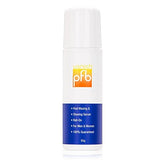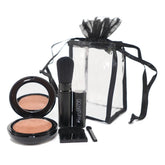Hair Care Guide
How you care for your hair will depend on its texture: whether it is dry, normal or greasy; and whether it has been chemically treated - bleached, dyed or permed. There are three main elements in hair care: cleaning or shampooing; conditioning; and brushing or combing. In addition, you may need to protect your hair from the sun or from chlorine and other chemicals.
Washing and Shampooing
The first and most important consideration in caring for the hair is keeping it clean. Hair gets dirty when sebum, an oily substance secreted by the skin's sebaceous glands, coats the shaft. Dead skin cells and airborne dirt stick to the sebum. Whether dry or greasy, hair should be washed as often as required to look good.
How often you wash your hair will depend on your hair, the weather, your lifestyle and how dirty it gets, plus the type of hair you have - dry, normal or greasy. As a rule, greasy hair needs shampooing more often than dry hair. Most experts recommend at least once a week washing to prevent dandruff from clogging the scalp. If you have an oily scalp, frequent shampooing will keep the hair from lying flat, weighted down by the fats in sebum. Shampoo will also reduce surface sebum, which contains high levels of testosterone and DHT that may re-enter the skin and affect the hair follicle. Very dry hair may be improved by massaging with a little olive or almond oil, covering and leaving on overnight, washing out next morning. If done gently, daily shampooing will not damage your hair.
Drying Hair
Since heat from curling irons and blow-dryers are notorious hair destroyers, to prevent damage, the best way to dry the hair is to let it dry naturally. The hair may be dabbed dry with a towel - over-vigorous rubbing can damage the hair, especially if it is fragile - and then left to dry slowly in the air. This will retain the maximum amount of moisture, and natural drying will tend to keep long, straight hair sleek and will usually allow curly hair to wave naturally.
Many people, however, do not have time to allow their hair to dry naturally, especially it it is thick or long, or it they have to go straight to work after washing, or go straight to bed. The easiest way to dry the hair is with a small, hand-held blow-drier. However, always remember that overheating can dry out and damage the hair.
You can encourage the hair to curl when blow-drying it by winding the hair around a brush and holding it in place in the jet of hot air, or by using a diffuser. Blow drying the hair with the head upside-down can create lift and body. Alternatively, for a smooth, sleek look, comb the hair straight when drying.
Finger-drying works well for short, spiky or curly hair. The action of the fingers will help the hair to stand up or curl, and the fingers are gentler on the hair than a comb or brush. You can also carry out a friction massage of the scalp at the same time.
Brushing and Combing
Hair should always be brushed when dry, never when wet, when it can easily be stretched or damaged.
Brush the hair gently from the scalp to disperse scalp oil over the hair. Start at the scalp and work down to the ends to ensure that the oil from the follicles will be distributed completely over the length of each strand. Brushing is especially important for long hair because the natural oils do not normally reach the ends, but it's equally beneficial for short hair. Brushing helps loosen knots and untangle the hair, and the action can loosen dead cells from the scalp and stimulate the circulation of the blood and then help promote hair growth. The action of brushing from the roots to the tips also helps smooth the cuticle and makes the hair shine.
If you prefer a comb, use a wide-toothed comb to avoid injury to your hair. Wide-toothed combs can be used when the hair is wet, and are also useful for spreading conditioner into the hair. They are essential if your hair is long.
Setting and Styling
All setting aids work by covering the hair shaft with a protective coating that when dry, help to hold the shape that has been created and prevent the absorption of moisture into the air, thus making the hair keep its shape for longer.
Setting aids contain weak glues that hold the hair in place. Setting lotions are normally runny and can be difficult to apply, because they tend to drip everywhere. Gels contain chemicals that stiffen the product, but which become less viscous when rubbed on your hands. Mousses are foams that contain very small bubbles of air - the smaller the bubbles, the more dense the foam. They are often used for scrunch and natural drying.
Certain hairstyles and treatments can cause breakage or root damage.
A styling gel or mousse can give your hair more body or thickness. They do not necessarily damage your hair, but you may experience extra dryness, especially at the hair ends. Products with natural ingredients are healthier for your hair.
Hair dyes work more like paint by covering hair strands with color or by mixing with the melanin granules without altering them. Dyes come in temporary form, which eventually wash out, and semi-permanent and permanent forms, conduct a patch test to check for possible irritation, because a severe allergic reaction to hair dye could cause hair loss.
Diet
The quality of your hair reflects in part the adequacy of your diet: regular, well-rounded meals are best for you and your hair. Iron deficiency, due to inadequate consumption of red meat or heavy menstrual bleeding in women, could cause hair shedding. Crash diets and eating disorders such as anorexia nervosa can damage hair dramatically.
Foods that are rich in iron and essential amino acids are important for fostering hair growth. So boost your intake of foods like:
- Lean red meat
- Offal (liver, kidneys, etc.)
- Fish
- Low-fat Cheese
As well, increase your intake of secondary sources of iron, like:
- Eggs (yolks)
- Dark green leafy vegetables
- Legumes (beans, lentils, etc.)
Vitamin C and folic acid also helps your body absorb the iron from your food.
Stress
Today's hectic lifestyles and the focus on staying slim have taken a heavy toll on women's health. Stress is a factor in many modern illnesses and is known to be linked to hair growth. Stress hormones can affect the growth of hair and can even lead to dramatic hair loss. An increasing number of young women in their 20s and 30s are experiencing premature thinning, or loss of hair. In other women, stress leads to a poor diet, which means that women do not eat enough protein, minerals and vitamins, and end up with dry, lack-luster and brittle hair. Crash dieting can lead to quite dramatic hair loss three months later. Because of the growth cycle of the hair, it takes that long before the effect of any major stress is actually seen on the hair. As a result, people often do not make a direct link between the hair loss and the cause. Anorexia and other eating disorders often also lead to hair loss.
It is widely believed stress can increase the production of androgens, the male sex hormones destined to kill hair follicles. Reducing your stress levels might cut production of androgens and slow hair loss and baldness. Make yourself easy, calm and relaxed.
- Choosing a selection results in a full page refresh.




